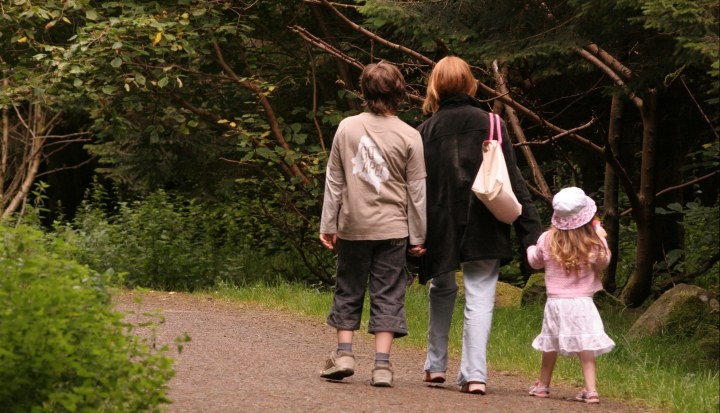By Alicia Marsland
This article appeared in the March 1985 issue of U.S. Catholic (Vol. 50, No. 3, pages 30-31). It is a reprint from Bringing Religion Home, published by Claretian Publications.
Black branches, brown fields, gray skies, sparrows perched stolidly as they bundle up feathers against chill air: this is the dead of winter. Teachers know this is the time their pupils run out of steam, and they themselves have trouble getting out of bed. Everyone plods through the day. Family tempers are misplaced.
Lent is upon us, the—forgive me—dreariest season of the church year. Of all seasons, this is probably my least favorite (unless I am trying to lose weight) and one I have difficulty sharing with the children. There are, thank God, resources for family Lenten activities; but even these may drag eventually. Nothing will ever make Lent a “jolly” time. True, but do we want it to be?
Lent is, symbolically, life’s winter. It is like the nitty-gritty work it takes to turn an inspiration into a book, a song, a quilt. It is hard; it is dull; it requires patience; it seems to go on forever. So do the frustrations and chores of daily life, even daily spiritual life.
You can’t hide
I may realize all this is a necessary part of life in the world where evil exists and humans often fall short of “the good that they would do,” but my natural reaction is to protect my children from all of that.
Alas, it is impossible. Youngsters know too well what it is to try to behave and end up biting their brother; they know how it feels to mouth off when they had meant to be quiet just this once. Their hearts break over the small wickednesses of their classmates. They struggle with envy, greed, boredom, anxiety, and the temptation to bend the truth. As a parent, I owe it to them to teach them both to face and cope with their darker side.
What can be invaluable in helping to do this are the very things that I like least about Lent. One of the unlikely aspects of life that keeps catching me by surprise, and which holds true in this case, is the fact that human beings have to go through darkness to see the light. People must repent their bad deeds before they can want to do better. A marriage often hits the rocks before a change can be made. Jesus died to accomplish the Resurrection.
The most consoling moments my children and I have shared came after we faced a bad thing together and grieved over it: a lie intended to put a sister in her place, a massacre on the news, my terrible temper, bitter words at school. How good to be able to say, “Yes, you did that, I did that, people do that, but it’s not always going to be this way. Someday, dead, we will shine like the sun in the morning.” How much better than to insist they cheer up, quit worrying about it, and pretend nothing ever went wrong.
This is what Lent reminds families of—that they cannot hide from the negative, they must transform it. St. Paul called Christians soldiers or athletes in training. They cannot, although they would dearly love to, skip directly from Christmas (the first awakening in faith) to Easter (the final glory.) Most of life lies in between. Joy comes naturally at Christmas, and joy comes easily to little ones but Lent is here to equip parents and children with virtues that don’t come easily: honesty, compassion, perseverance, discipline, hope that helps in the teeth of adversity, courage to stand up for the right.
Everyone’s a hero
Where do children find their strengths? In Lent, that yearly recognition of the long haul, and in every time they face a wrong, do an irksome task, give something up for a good cause, realize anew that death and suffering exist, or keep at something “when the thrill is gone.” When children understand this, they rise to the occasion. Heroism is something they appreciate. They may even go overboard, expecting more than they are capable of. With some understanding guidance from parents, they can still come out ahead, acquiring another of Lent’s precious gifts: a bit of humility.
The observances of Lent are so many springboards for talking with children about the basic truths about humanity and life: for example, how abstinence is more than denying oneself, it is a form of freedom. The light in the eyes of a son who discovers that he really does have an alternative to watching TV all day—and that he even likes it better—is worth the initial grumbling. A daughter will share a chuckle when parents confess their resolve crumbled in the face of a fudge-chocolate cake. Sons and daughters will discover parents still fall a mite short of holiness. They will learn even more when parents pick up the pieces of their broken resolutions and start again.
When families face these challenges together, gloomy Lent surprises everyone, turning out to be a way human beings go through darkness to light. For everyone, Lent’s final lesson is that, always, when people least expect it, when it seems winter will never end, that the White Witch reigns forever, the ice will crack with a booming roar, the waters will burst free, sunshine will warm a blue sky, and the birds will learn to sing again.
This article appeared in the March 1985 issue of U.S. Catholic (Vol. 50, No. 3, pages 30-31). It is a reprint from Bringing Religion Home, published by Claretian Publications.
Image: ©morgueFile/hotblack













Add comment